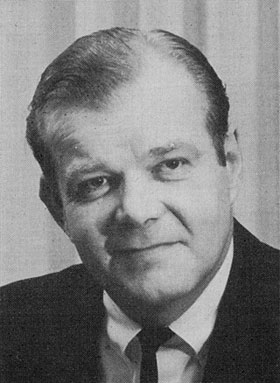
UA Heritage: An Interview with Bill Putnam, Sr.; Part Three
By Larry Blakely
Reprinted with permission from the pages of Mix magazine.
 |
| Bill Putnam |
"I made the decision to leave Chicago, where I was a big frog in a small pond, and move to Los Angeles. I looked forward to this new challenge in the recording capital of the world. And though many of my Chicago clients had promised to support me in this move by recording at my new facility in Los Angeles, I realized that going "head to head" against the legendary Radio Recorder, the giant of the independent recording studios, was serious business.
"I moved to Hollywood in 1957 and sold my interest in Universal Recording. The late Bernie Clapper became President of Universal after I left. Two key individuals who had worked with me in Chicago joined me on my trek westward. They were Tony Parri, the controller of Universal, and Jerry Ferree, who became our chief engineer. Later, Bob Bushnell, Malcolm Chisholm and Bob Golden also left Chicago and joined us in the west.
"Since 1948 I had been in regular communication with Les Paul, and we had become close friends. I met Les through the legendary Gene Austin of "My Blue Heaven" fame. Les and Gene had made about 30 sides together, and I had arranged to release them on my Universal label. Moving to Hollywood kept me in touch with Les on a regular basis, and for me, this was a ball! I hold Les Paul in high esteem, and I stand in awe of what he contributed to the recording industry. The NARAS award to him last year was a nice accolade, but I don't know why they waited so long.
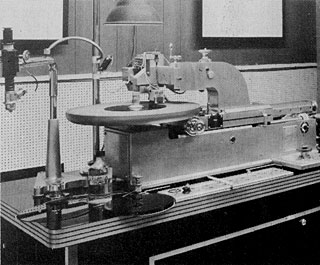 |
| Scully Lathe in the mono mastering suite at United |
"The new parent company was to be named United Recording Corp., and by mid-1958 much planning had already taken place. We were making a valiant attempt to incorporate as many technological innovations in this facility as possible. (This all came at a great time, since stereo was busting the industry wide open.)
"I located a building at 6050 Sunset Boulevard, near "Gower Gulch" (CBS Radio studios and Columbia Pictures lot). This facility was formerly the Jerry Fairbanks movie soundstage, and was a decrepit shell, but the space was adequate and the location good. I brought Mr. Curt Esser out from Chicago, who had worked with me at Universal as the architect. The financing for United came from the proceeds from the sale of my majority interest in Universal of Chicago. I used notes from this sale to collateralize additional borrowing. As part of the plan to raise additional capital, many of our clients, musicians and arrangers acquired minority interests and even brought in other investors.
"The pressure to get "on the air" in Hollywood led me to purchase Master Recorders on Fairfax Avenue from Bunny and Rose Robyn. This decision was prompted by Randy Wood, president/founder of Dot Records and probably the most singularly important person in my decision to move to Hollywood. Actually, at one point we had entered into serious negotiations to purchase Radio Recorders (7000 Melrose Avenue), but for a number of reasons the deal was never consummated.
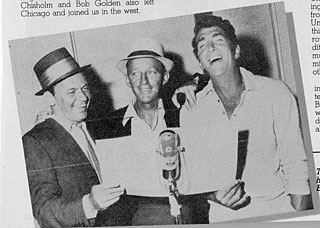 |
| Three famous faces from Unitedís halcyon days: Frank Sinatra, Bing Crosby and Dean Martin |
"During the time that United Recording was being built, I was recording a lot of dates at Master Recorders for Dot, Imperial, Liberty, Mercury and some twenty other labels. I recorded all the "hot" Dot acts, as well as Ricky Nelson's sides for Imperial (Ozzie, his father, was the producer). Bunny Robyn had made most of the Fats Domino hits at Master Recorders and also at Universal Recorders of California (no connection with the Universal in Chicago), where he was previously a mixer.
During this exciting period of the '60s, and into the '70s, the studios were jumping 24 hours a day, 7 days a week … --Bill Putnam, Sr.
"In 1958 we completed Studio B at United, along with two reverb chambers. I think Johnny Mann recorded the first date there. The rest of the plant was still under construction and, during this time, I was doing dates at both United and Master Recorders. We actually kept Master Recorder going for a year after the United facilities were completed in early 1959. All of us who did engineering were mixing dates around the clock. Bunny Robyn had joined us and stayed with United as its first vice president for three years. But Morris came to United from Universal (in Hollywood) where he was chief mixer. Eddie Brackett and Ben Jordan came over from Radio Recorders, and Malcolm Chisholm also joined us. United grew and grew--with three studios, a mixdown room, three mastering rooms (including one with "stereo!") and a small manufacturing plant, all in 15,000 square feet of building.
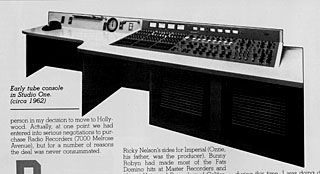 |
| Early tube console in Studio One (circa 1962) |
"We had Studio A (approximately 60,000 cubic feet), Studio B (approximately 35,000 cubic feet) and Studio C, a small dialogue studio where we did many of the early Hanna Barbera shows such as The Flintstones. Studios F and D were mono mastering rooms which were equipped with Scully lathes and Westrex or Grampian cutter heads. Most clients insisted on the Grampian head for hot singles. The Westrex was more widely accepted for LPs where level was not the prime consideration. (Remember, in those days we were still making masters in both mono and stereo for the same release. It was done this way up to the mid-'60s.) Studio G was our stereo mastering room which used the Fairchild "vertical/lateral" system, which was electronically matrixed for 45/45 stereo.
"We built our first mixdown room, Studio E, though there was not much to do when mixing down three tracks. (Four-track came a little later.) Studio A had its own unique and permanently assigned 3,000-cubic-foot stereo echo chamber, which became quite famous over the years. There were four other good-sized chambers and a small one over B control room. We also had a maintenance shop, tape libraries and "not enough" air conditioning.
 |
| The Ventures in session at United Studios in the early 1960s |
"In the early 1960s, we began negotiations to acquire Western Recorders at 6000 Sunset from Don Blake, Bill Kirkpatrick and Ted Robinson. This was ideal as it was just one block away from United. We made the deal and quickly began to completely remodel Western. Part of the facility was the 6000 Radio Center Theater, which had been the origin of many network radio shows during the heyday of network radio. This was now to be remodeled and become the Studio 1 of Western Recorder.
"Many alumni from Radio Recorders joined our ranks: Artie Becker (who was tops in the ad agency field), Bones Howe (who was the best jazz-music mixer in the business), Jim Economides, Walt Payne and others who departed the legendary Radio Recorders for United. One day Stan Kenton was telling me about a guy in Oregon who did big band remotes for kicks. He wanted a job in Hollywood in the worst way. His name was Wally Heider. He came aboard, and (needless to say!) has gone on to make a great name for himself. He is, in my opinion, the best big-band mixer that ever happened. His remotes had no equal.
"After the acquisition of Western Recorders in 1961 and our extensive remodeling program, our total facility consisted of two plants, one at 6050 and the other at 6000 Sunset. Our corporate offices and accounting were located in United at 6050 Sunset. At Western, we had the traffic office for both plants, headed by Dick Sexty and Lela Greenstone who was Dick's girl Friday. Western's volume grew 400% in two short years.
"At Western, Studio 1 was the old Radio Center, which had over 300 seats. We removed them, poured in a flat floor and ended up with a nice large studio of approximately 65,000 cubic feet. Studio 2 originally had a 10-foot ceiling, which we raised to 17 feet. Studio 3 was made from the space that we had left over. As fate would have it, this was the studio which became legendary, to the extent that its reputation warranted its being copied by Wally Heider. (He even named the copy Studio 3 when he started his first recording company. This was very flattering. This was not the only copy. There was also one in Canada and in Maryland, each publicizing the fact that it was a replica of the famous United Western Studio 3 in Hollywood.) This was the famous studio that was home for the Beach Boys, Glen Campbell, the Mamas & the Papas, Johnny Rivers, Jan and Dean, Sonny and Cher, Herb Alpert, Mike Post, Linda Ronstadt, Rick Nelson, Three Dog Night, Grass Roots, Baja Marimba Band, Connie Francis, The Everly Brothers, The Association, Kenny Rogers, The Lettermen, and on and on. …
"We had a bronze plaque listing all these million-selling artists who had started their careers in Studio 3. The guys who made that studio work were Bones How, Hal "Lanky" Lindstrot, Phil Kaye, Chuck Britz and many others.
"The other facilities at Western included another mastering room with a Scully lathe and a Westrex cutter. We also had a disk dubbing room with four Arcturus lathes, a maintenance shop, two production rooms for tape copies; we added another stereo mastering room, stereo echo chambers and several EMTs. We also had the ten tie lines that ran the half block between United and Western, which were flat to 15 kHz.
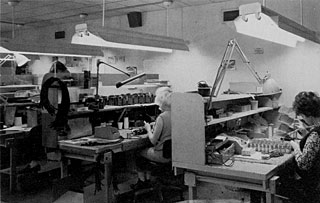 |
| The first assembly line at 6050 Sunset |
United continued to grow in combination with the new facilities at Western. Business was great and we were on a real roll. We purchased Sound Recorders in San Francisco and then changed its name to Coast Recorders. Don Geis, from our Hollywood staff (another Universal Recorders of California alumnus) moved to San Francisco and became the first manger.
"Winston Wong, one of Sound Recorders' original partners, became a top mastering engineer at United. Bob Doherty was managing the studio operations at United and Western, in addition to mixing a lot of dates. We had a closed shop (all IBEW engineers) until the mid-'60s. There was a staff of 12 top-notch mixers, 6 to 8 recordists, 4 or 5 guys doing mastering, 2 to 3 apprentices doing setup, 4 or 5 people in maintenance and a chief engineer. To my knowledge, no other independent custom studio has ever reached the size in total facilities, staff, breadth of service, and revue production of the combined United, Western and Coast Recorders.
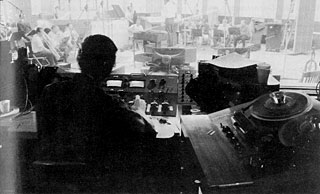 |
| A typical “orchestra” date at United in the early '60s |
"When Decca closed its Hollywood studios in the early '60s, Andy Richardson, Al Butow and Lee Hirschberg (now recording manager at Warner Brothers Records), all joined United. Rudy Hill, another United alumnus, still works for Lee at Warners. Rudy worked more dates with me than any other person, first as a setup man and later as second engineer. Al McPherson, now head of maintenance for Warner Brothers, was active in the same role at United for many years. Bob Doherty was recruited from MGM Records in New York in the early '60s. He put in a lot of hours as a super mixer and later became vice president and general manger of all studio operations, a position he held for many years. Bill Perkins, a famous jazz tenor sax player with Stan Kenton, became a most sought-after mastering engineer at United. Bill is now playing tenor sax on the Carson show.
"With the large volume of studio dates and the expanding staff of mixers, we established a procedure which required each mixer or second engineer to prepare a studio setup sheet. For convenience, we printed a form with a scale drawing of each studio, with numbered and lettered grids. These setup sheets served several useful purposes. They are an historic record of the recording date showing the types of mikes used on each section of the orchestra, their respective input position, location of risers, isolation screens, parallel or series boxes and any other special inboard or outboard equipment needed for the date. If we were doing an album, it was particularly useful for future dates.
 |
| The test department at Universal Audio in 1962 |
"Our typical microphone arrangement would be: string AKG C-60; reed RCA 77DX; brass Neumann U47 and RCA 77DX; drum Neumann KM56; piano RCA 44BX; bass RCA 77DX; percussion Sony C21; guitar Electro-Voice 666; Celeste E-V 666; and vocal AKG C-60.
"During this exciting period of the '60s, and into the '70s, the studios were jumping 24 hours a day, 7 days a week, and Warner Brothers was our largest account.
"The growth of the recording studio peaked between the late '60s and early '70s, at which point the very nature and essence of the recording business began to change. And, for me, so ended much of the personal satisfaction and enjoyment that had always been a motivating force to me. From 1967 to 1970 my personal activity was rich in every area connected with sound recording, from studio design, acoustics, product design and their related fields. The many dreams of my childhood and the early years of my business career had, for all intents and purposes, been realized. I can hardly think of anyone who was contemporary to that period, whom I have not recorded. Those whose talents I had idolized had become my friends, and to have gained their professional respect was a great reward.
"Nelson Riddle introduced me to Frank Sinatra, and our first meeting was on the occasion of a TV special, which was prerecorded. Frank was in the process of winding up his contract with Capitol and owed them some sides, which we finished at United. Then we became active in the inception of Frank's new record label, Reprise Records (which later was acquired by Warner Brothers).
"One of the early dates we did for Reprise was Bing Crosby and Frank Sinatra together. This was a momentous occasion. I first met Bing on a TV prerecord late in the '50s, and I kept on recording him after that. On this same Reprise date were Dean Martin, Sammy Davis and Johnny Mercer. To say the least, this was the living end for me.
"The Ray Charles country album which Sid Feller produced was the Grammy Record of the Year in the year it was released. I received a nomination for Best Engineered Record for that one, but lost out to The Chipmunks. However, Ray's "I Can't Stop Loving You" (which I recorded) has become a classic in the country/western blues field.
"It might be of interest to explain how the record companies operated then as compared to now. There is a significant difference in the relationship between the record company and the recording studio (when comparing the period of the 1950s and early 1960s) to the style of operation that exists today. The major record companies--Columbia, RCA, Decca and Capitol--operated their own studios and at the head of the creative department was a Director or Artist and Repertoire or "A&R" head. He was an artistic administrator, guiding the contractual negotiations with artist, finding new talent, picking material, and in most instances producing dates with some of the labels' top artists as well as supervising other producers in the A&R department. In most instances an A&R man worked with the same artist over and over, particularly when he had made a few hits with that artist.
"The same era also produced a growing number of independent labels: Mercury, Dot, MGM, Chess, Liberty, Kapp, Warner Bros., Atlantic, King, Imperial, ABC, Paramount, A & M, Colpix, United Artist, Reprise, Time and a rapidly growing list.
"Independent record companies had a different style of management for the creative sides of the business. There was hands-on supervision of record dates by the owner or owners of the label. This also applied to the selection of material for the artists. The artist cooperatively took directions and accepted the material selected by the boss. This was done with few exceptions.
"Making records in those days was a heck of a lot of fun. In the two- or three-track era, when you walked out of the control room after a date, what you heard was what you got! Sometimes, if it was a rush release, we would master the same day and distributors would have product in four days!
"All of this was encapsulated in a time frame which was also a transition period, when the independent producer became dominant and the old guard A&R department saw its demise. Then came the artist/producer-owned studio, the small single studio-style operation, and the evolution of new technology which brought the whiz kids out of the woodwork. Not just in Hollywood, but everywhere in the world. It became more and more difficult to compete in a fragmented market. We shifted gears many times, and it is remarkable that we were able to weather the storm time and time again. Many others were not so fortunate.
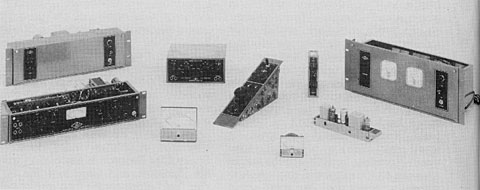 |
Some of the first Universal Audio product line: 60 watt stereo monitor amp, 175 limiter, 550 Equalizer, 610 Microphone input module, 508A Equalizer, 1008 Cascade tube preamp, console power supply |
"In 1971 we leased the United Studios to Jerry and Joan Barnes, who operated Studios A and B for several years. We later combined all the operations under the banner of United/Western Studios with the total operation managed by Jerry Barnes. The operation became more diversified and, out of necessity, Studio 1 was converted to a scoring stage with projection, and we expanded the facilities more in the direction of TV and motion picture scoring.
"To this point, I have failed to mention Universal Audio, the UREI forerunner. In 1958 we installed Universal Audio, the fledgling manufacturing company that I had brought with me from Chicago. We moved this into the upstairs area of United at 6050 Sunset (along with its four employees). Larry Kessler, who also came with me from Chicago, was engineering in the studios and running Universal Audio as well. At this time, we were building the Universal Audio 100D Preamp, 101A Line Amp and the 50BA Equalizer as well as designing and construction custom consoles.
"Meanwhile, Universal Audio had acquired all the assets of a company called Studio Electronics Corp., and we moved this manufacturing operation to the Western building at 6000 Sunset. Later we moved it to a small factory building on Valerio Street in North Hollywood. We then purchased the broadcast division of Babcock Electronics. Through this purchase we acquired the [Jim Lawrence] patent rights to the popular LA-2A Leveling Amplifier (limiter), which evolved in the LA-3A, then the LA-4.
"We changed the manufacturing company's name to UREI, and D.F. "Bud" Morris did double duty as corporate, executive vice president and manager of UREI until URC's sale this year. We embarked on the development of additional products and expanded our marketing worldwide. Warren Gilman, Bob Bushnell and Deane Jensen were designing new products in addition to custom consoles. In the late '60s Brad Plunkett joined us, with not only many innovative ideas, but above all a fresh and forward-looking approach to product design and development.
"UREI always strove for product diversity and innovation. In 1974 UREI acquired the assets of National Intertel Corp. through a bulk sale purchase. This became the Teletronix division of UREI. The marketing of Teletronix products is now handled exclusively by the Tel-Med multiple-line telephone information system hardware. This is the only area of manufacturing at UREI which is separate from the audio field. Teletronix contributed substantially to the overall growth of UREI.
"At one time we successfully manufactured and marketed a hazardous fume detector for power boats known as Gasgard. In 1963 we acquired Waveforms, Inc., a New York-based manufacturer of audio instrumentation products. After several years of various attempts to modernize and expand the product line, we expunged it, and Waveforms is no more.
"UREI accrued a large inter-company debt to United during its early growth stage, but we kept the faith and this turned out to be a well-founded decision. The expansion and healthy growth of UREI allowed me a continuing opportunity to develop new products when time permitted. The satisfaction of this activity has been one of the most rewarding parts of my life. I used to refer to this as my spare-time activity, but it was really given a higher priority than I realized. From this came the 1176 FET Limiter; 1108 FET Preamp and Remote Feedback Equalizer; the first Microfoam Module; the Cooper Time Cube in conjunction with Duane Cooper; the 813 family of speakers in conjunction with Ed Long; and, oh yes, one I would like to forget about, the Electrostatic Reverberator. Other innovations which were the result of this facet of my personal activity were the early control room design specifically for stereophonic recording, first published in the AES Journal in 1960; the introduction of the "120 Mastering Process" and most recently, the Horn Coupled Control Room, published in the AES Journal in 1983.
"Bud Morris, Ray Combs and Dick Siminsky, together with Brad Plunkett's great creativity and engineering talent, led UREI from a tiny, struggling infant to a major force in the professional audio industry. The innovations which germinated and blossomed from this combination of companies and people later became URC [United Recording Corporation] companies. The result was a one-of-a-kind amalgamation of small companies in the recording studio business, combined with a growing electronics manufacturing company. From the studio came new product ideas which were born out of a need or desire to find better ways of doing things. The collection of talent offered by this combination resulted in a very meaningful, synergistic effect.
"I am frequently asked to comment on how I see the future of the industry. The coming direction from of the recording studio business will be dictated by how fast the compact disc captures a substantial share of the market. The compact disc is an important and vital development that can revive the industry as stereo did in the late '50s. It means that the hardware market for professional studio gear will be revitalized. Existing analog studio equipment will not be acceptable and its life expectancy therefore has been reduced dramatically. Just imagine, for the first time we have a situation where the potential quality of reproduction, at the terminal point of the end user, exceeds the capability of the average professional recording studio in its present technical state.
"I've been very fortunate to be involved in many areas of activity that have brought me a great amount of enjoyment. I enjoyed the challenge of running a business, but above all I enjoyed the association with my colleagues. I also appreciate the opportunity to tell the story of Universal, United and the URC Companies. I would be less than honest if I did not explain that intrinsic to this story is a deep sadness, from the loss this last year of my wife Miriam Putnam. "Tookie," as she was known by her friends, grew up in the record business under the tutelage of a very famous man in our industry, the late Dave Kapp, who was president of Kapp Records. She later went to work for Frank Sinatra in Hollywood when he started Reprise Records, and it was through Frank that we met and were married over twenty years ago. It was my exceptional good fortune to have the closeness of our relationship, as well as a wife who knew the business. She understood what "it" was all about, and what I was all about. This kept her so enthusiastically helpful, supportive, and very much involved in everything I did over the years. Most important of all she gave me two great children, Bill and Jim. I wish this could have been written with her help, and it is to her that I dedicate this story, with all my unending love and devotion."